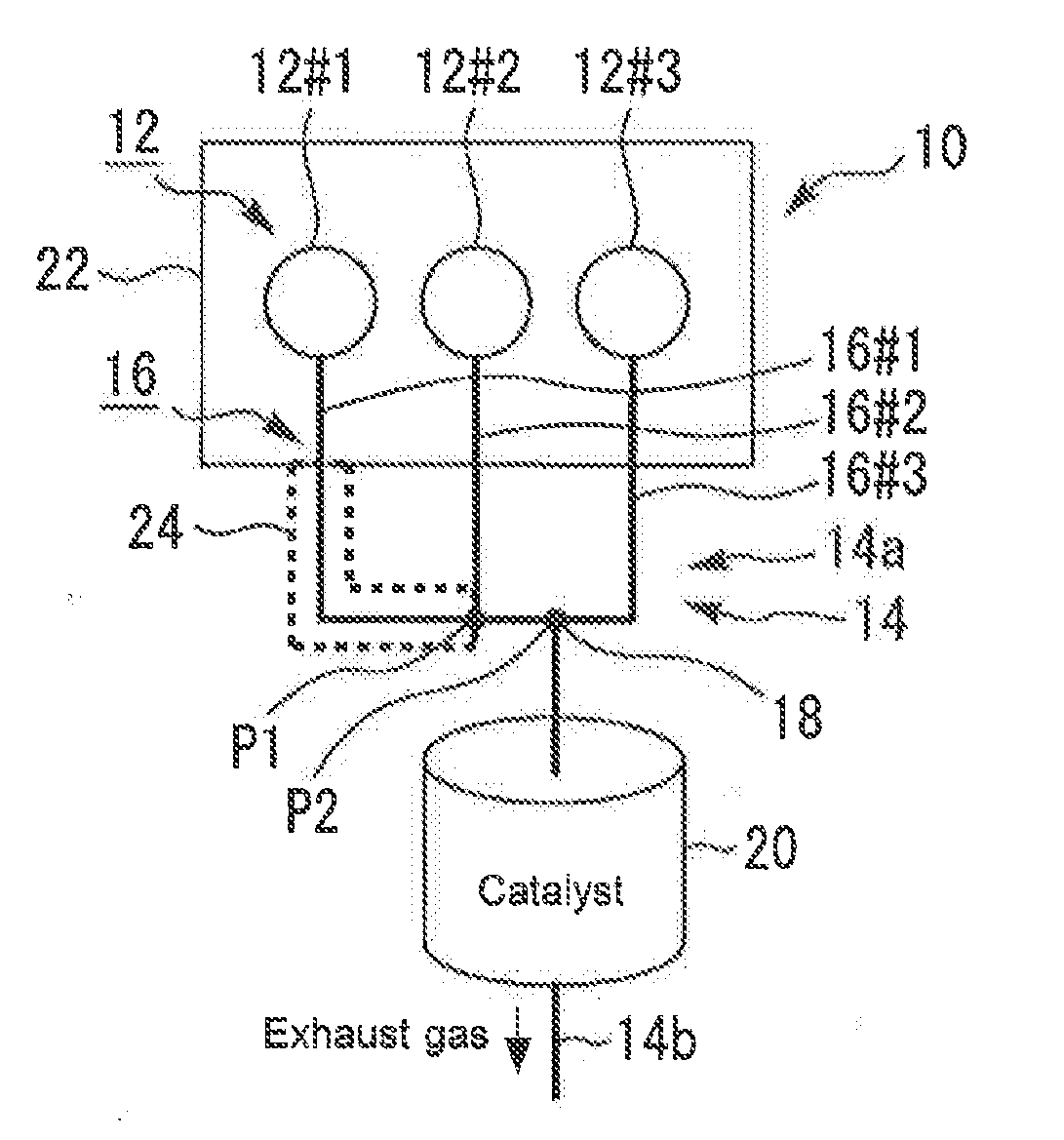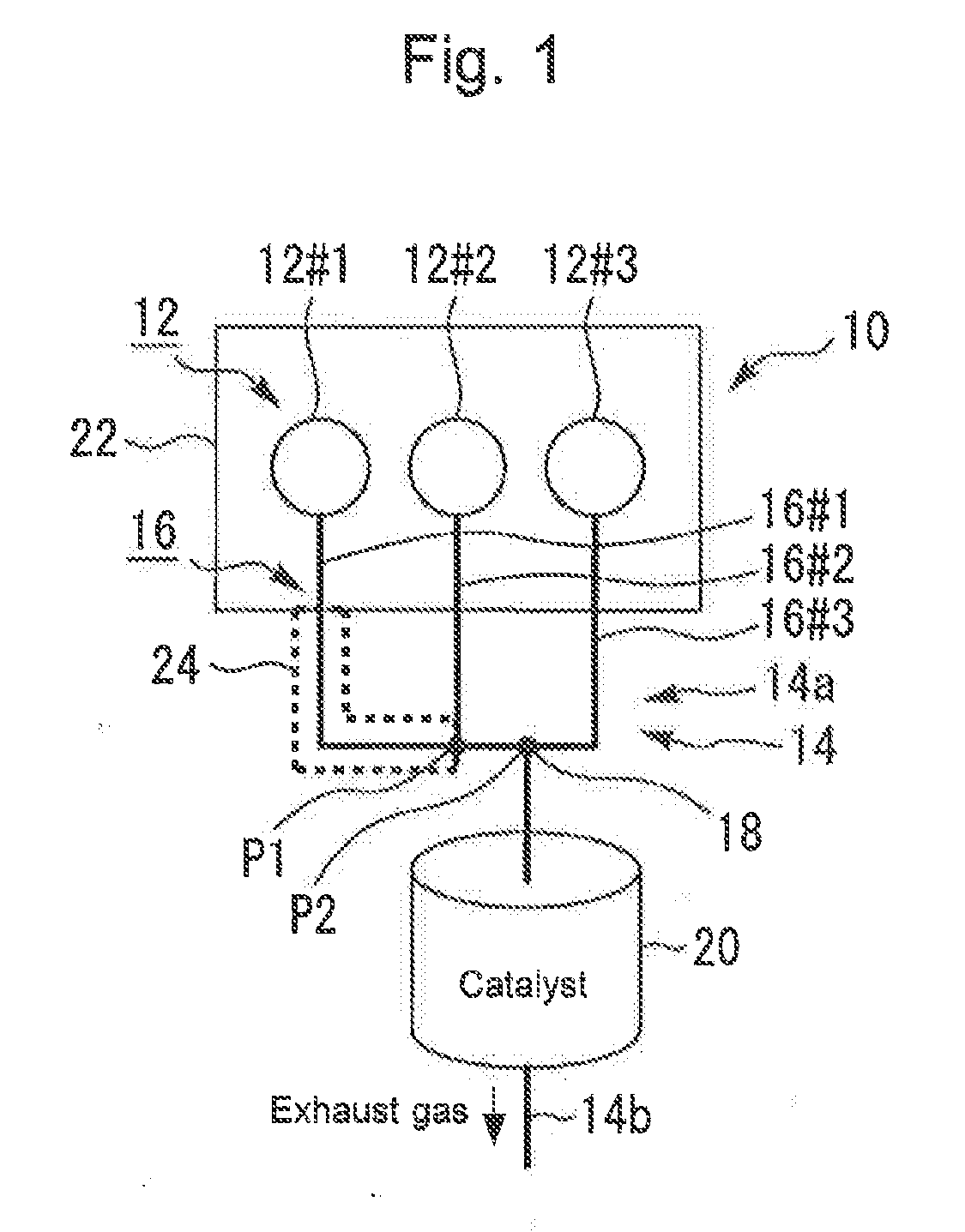Internal combustion engine
- Summary
- Abstract
- Description
- Claims
- Application Information
AI Technical Summary
Benefits of technology
Problems solved by technology
Method used
Image
Examples
first embodiment
[0062]FIG. 1 is a schematic diagram that illustrates a configuration of an internal combustion engine 10 according to the first embodiment of the present disclosure. The internal combustion engine 10 shown in FIG. 1 is an in-line three-cylinder engine that includes three cylinders 12#1, 12#2 and 12#3. The internal combustion engine 10 is provided with an exhaust channel 14 through which exhaust gases from these cylinders 12 flow. In the following description, if there is no need to distinguish the cylinders 12#1 to 12#3 from each other, they may be simply referred to as “cylinders 12”. In addition, with respect to not only the cylinders 12 but also other components, reference numerals may be similarly abbreviated in this manner.
[0063]The exhaust channel 14 is provided with a manifold channel 14a and a common channel 14b. The manifold channel 14a is provided with three branch channels 16#1, 16#2 and 16#3 connected to the respective three cylinders 12, and a collective portion 18 wher...
second embodiment
[0082]Next, a second embodiment of the present disclosure will be described with reference to FIG. 8, FIG. 8 is a schematic diagram that illustrates a configuration of an internal combustion engine 70 according to the second embodiment of the present disclosure. In addition, in each of the second embodiment and the subsequent embodiments, a channel wall around a hollow layer and the wall (outer wall) of the hollow layer can be similarly formed by means of, for example, a three-dimensional modeling device, as shown in FIGS. 2 and 3. Because of this, in each of these embodiments, the illustration of the channel wall around the hollow layer and the wail of the hollow layer and explanation thereof are omitted or abbreviated.
[0083]An exhaust channel 70 of the internal combustion engine 70 shown in FIG. 8 is provided with the manifold channel 72a having three branch channels 74#1, 74#2 and 74#3. The exhaust gases from the three branch channels 74 are collected into one at once at a collec...
third embodiment
[0086]Next, a third embodiment of the present disclosure will be described with reference to FIG. 9.
[0087]FIG. 9 is a schematic diagram that illustrates a configuration of an internal combustion engine 80 according to the third embodiment of the present disclosure. The internal combustion engine 80 shown in FIG. 9 is an in.-line four-cylinder engine that includes four cylinders 82#1, 82#2, 82#3 and 82#4. An exhaust channel 84 of the internal combustion engine 80 is provided with a manifold channel 84a. The manifold channel 84a is provided with four branch channels 86#1, 86#2, 86#3 and 86#4 that are connected to the respective cylinders 82.
[0088]The exhaust gases from four branch channels 86 are collected into one at once at a collective portion 88. The lengths of the four branch channels 86 are different from each other. In more detail, as shown in FIG. 9, the branch channel 86#1 is the longest, followed by the branch channel 86#2, the branch channel 86#3 and the branch channel 86#4...
PUM
 Login to View More
Login to View More Abstract
Description
Claims
Application Information
 Login to View More
Login to View More - R&D
- Intellectual Property
- Life Sciences
- Materials
- Tech Scout
- Unparalleled Data Quality
- Higher Quality Content
- 60% Fewer Hallucinations
Browse by: Latest US Patents, China's latest patents, Technical Efficacy Thesaurus, Application Domain, Technology Topic, Popular Technical Reports.
© 2025 PatSnap. All rights reserved.Legal|Privacy policy|Modern Slavery Act Transparency Statement|Sitemap|About US| Contact US: help@patsnap.com



